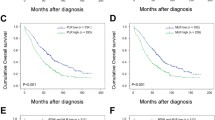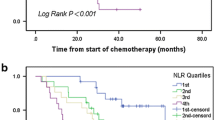Abstract
Meigs’ syndrome (MS), a rare complication of benign ovarian tumors, is easily misdiagnosed as ovarian cancer (OC). We retrospectively reviewed the clinical laboratory data of patients diagnosed with MS from 2009 to 2018. Serum carbohydrate antigen 125 and HE4 levels were higher in the MS group than in the ovarian thecoma-fibroma (OTF) and healthy control groups (all P < 0.05). However, the serum HE4 levels were lower in the MS group than in the OC group (P < 0.001). A routine blood test showed that the absolute counts and percentages of lymphocytes were significantly lower in the MS group than in the OTF and control groups (all P < 0.05). However, these variables were higher in the MS group than in the OC group (both P < 0.05). The neutrophil-to-lymphocyte ratio (NLR) was also significantly lower, whereas the lymphocyte-to-monocyte ratio was higher in the MS group than in the OC group (both P < 0.05). The NLR, platelet-to-lymphocyte ratio, and systemic immune index were significantly higher in the MS group than in the OTF and control groups (all P < 0.05). The hypoxia-inducible factor-1 mRNA levels were also significantly higher, whereas the glucose transporter 1, lactate dehydrogenase, and enolase 1 mRNA levels were lower in peripheral CD4+ T cells obtained preoperatively in a patient with MS than those in patients with OTF, patients with OC, and controls (all P < 0.05). The expression of these four glucose metabolism genes was preferentially restored to normal levels after the tumor resection of MS (P < 0.001). These clinical laboratory features can be useful in improving the preoperative diagnostic accuracy of MS.
Similar content being viewed by others
References
Chechia A, Attia L, Temime RB, Makhlouf T, Koubaa A. Incidence, clinical analysis, and management of ovarian fibromas and fibrothecomas. Am J Obstet Gynecol 2008; 199(5): 473.e1–473.e4
Sfar E, Ben Ammar K, Mahjoub S, Zine S, Kchir N, Chelli H, Khrouf M, Chelli M. Anatomo-clinical characteristics of ovarian fibrothecal tumors. 19 cases over 12 years: 1981–1992. Rev Fr Gynecol Obstet 1994; 89(6): 315–321 (in French)
Sivanesaratnam V, Dutta R, Jayalakshmi P. Ovarian fibroma-clinical and histopathological characteristics. Int J Gynaecol Obstet 1990; 33(3): 243–247
Meigs JV. Fibroma of the ovary with ascites and hydrothorax: Meigs’ syndrome. Am J Obstet Gynecol 1954; 67(5): 962–985
Nicoll JJ, Cox PJ. Leiomyoma of the ovary with ascites and hydrothorax. Am J Obstet Gynecol 1989; 161(1): 177–178
Meigs JV, Cass JW. Fibroma of the ovary with ascites and hydrothorax: with a report of seven cases. Am J Obstet Gynecol 1937; 33(2): 249–267
Meigs JV. Fibroma of the ovary with ascites and hydrothorax: a further report. Ann Surg 1939; 110(4): 731–754
Okuda K, Noguchi S, Narumoto O, Ikemura M, Yamauchi Y, Tanaka G, Takai D, Fukayama M, Nagase T. A case of Meigs’ syndrome with preceding pericardial effusion in advance ofpleural effusion. BMC Pulm Med 2016; 16(1): 71
Renaud MC, Plante M, Roy M. Ovarian thecoma associated with a large quantity of ascites and elevated serum CA 125 and CA 15-3. J Obstet Gynaecol Can 2002; 24(12): 963–965
Timmerman D, Moerman P, Vergote I. Meigs’ syndrome with elevated serum CA 125 levels: two case reports and review of the literature. Gynecol Oncol 1995; 59(3): 405–408
Morán-Mendoza A, Alvarado-Luna G, Calderillo-Ruiz G, Serrano-Olvera A, López-Graniel CM, Gallardo-Rincón D. Elevated CA125 level associated with Meigs’ syndrome: case report and review of the literature. Int J Gynecol Cancer 2006; 16(Suppl 1): 315–318
Dong R, Jin C, Zhang Q, Yang X, Kong B. Cellular leiomyoma with necrosis and mucinous degeneration presenting as pseudo-Meigs’ syndrome with elevated CA125. Oncol Rep 2015; 33(6): 3033–3037
Danilos J, Michał Kwaśniewski W, Mazurek D, Bednarek W, Kotarski J. Meigs’ syndrome with elevated CA-125 and HE-4: a case of luteinized fibrothecoma. Przegl Menopauz 2015; 14(2): 152–154
Son CE, Choi JS, Lee JH, Jeon SW, Hong JH, Bae JW. Laparoscopic surgical management and clinical characteristics of ovarian fibromas. JSLS 2011; 15(1): 16–20
Laganà AS, Vergara D, Favilli A, La Rosa VL, Tinelli A, Gerli S, Noventa M, Vitagliano A, Triolo O, Rapisarda AMC, Vitale SG. Epigenetic and genetic landscape of uterine leiomyomas: a current view over a common gynecological disease. Arch Gynecol Obstet 2017; 296(5): 855–867
Laganà AS, Colonese F, Colonese E, Sofo V, Salmeri FM, Granese R, Chiofalo B, Ciancimino L, Triolo O. Cytogenetic analysis of epithelial ovarian cancer’s stem cells: an overview on new diagnostic and therapeutic perspectives. Eur J Gynaecol Oncol 2015; 36(5): 495–505
Bellia A, Vitale SG, Laganà AS, Cannone F, Houvenaeghel G, Rua S, Ladaique A, Jauffret C, Ettore G, Lambaudie E. Feasibility and surgical outcomes of conventional and robot-assisted laparoscopy for early-stage ovarian cancer: a retrospective, multicenter analysis. Arch Gynecol Obstet 2016; 294(3): 615–622
Grivennikov SI, Greten FR, Karin M. Immunity, inflammation, and cancer. Cell 2010; 140(6): 883–899
Mantovani A, Allavena P, Sica A, Balkwill F. Cancer-related inflammation. Nature 2008; 454(7203): 436–444
Margetts J, Ogle LF, Chan SL, Chan AWH, Chan KCA, Jamieson D, Willoughby CE, Mann DA, Wilson CL, Manas DM, Yeo W, Reeves HL. Neutrophils: driving progression and poor prognosis in hepatocellular carcinoma? Br J Cancer 2018; 118(2): 248–257
Sanchez-Salcedo P, de-Torres JP, Martinez-Urbistondo D, Gonzalez-Gutierrez J, Berto J, Campo A, Alcaide AB, Zulueta JJ. The neutrophil to lymphocyte and platelet to lymphocyte ratios as biomarkers for lung cancer development. Lung Cancer 2016; 97: 28–34
Templeton AJ, Ace O, McNamara MG, Al-Mubarak M, Vera-Badillo FE, Hermanns T, Seruga B, Ocaña A, Tannock IF, Amir E. Prognostic role of platelet to lymphocyte ratio in solid tumors: a systematic review and meta-analysis. Cancer Epidemiol Biomarkers Prev 2014; 23(7): 1204–1212
Templeton AJ, McNamara MG, Šeruga B, Vera-Badillo FE, Aneja P, Ocaña A, Leibowitz-Amit R, Sonpavde G, Knox JJ, Tran B, Tannock IF, Amir E. Prognostic role of neutrophil-to-lymphocyte ratio in solid tumors: a systematic review and meta-analysis. J Natl Cancer Inst 2014; 106(6): dju124
Abramov Y, Anteby SO, Fasouliotis SJ, Barak V. Markedly elevated levels of vascular endothelial growth factor, fibroblast growth factor, and interleukin 6 in Meigs syndrome. Am J Obstet Gynecol 2001; 184(3): 354–355
Abramov Y, Anteby SO, Fasouliotis SJ, Barak V. The role of inflammatory cytokines in Meigs’ syndrome. Obstet Gynecol 2002; 99(5 Pt 2): 917–919
Dang EV, Barbi J, Yang HY, Jinasena D, Yu H, Zheng Y, Bordman Z, Fu J, Kim Y, Yen HR, Luo W, Zeller K, Shimoda L, Topalian SL, Semenza GL, Dang CV, Pardoll DM, Pan F. Control of TH17/Treg balance by hypoxia-inducible factor 1. Cell 2011; 146(5): 772–784
Shi LZ, Wang R, Huang G, Vogel P, Neale G, Green DR, Chi H. HIF1α-dependent glycolytic pathway orchestrates a metabolic checkpoint for the differentiation of TH17 and Treg cells. J Exp Med 2011; 208(7): 1367–1376
Liu G, Bi Y, Xue L, Zhang Y, Yang H, Chen X, Lu Y, Zhang Z, Liu H, Wang X, Wang R, Chu Y, Yang R. Dendritic cell SIRT1-HIF1α axis programs the differentiation of CD4+ T cells through IL-12 and TGF-α1. Proc Natl Acad Sci USA 2015; 112(9): E957–E965
Macintyre AN, Gerriets VA, Nichols AG, Michalek RD, Rudolph MC, Deoliveira D, Anderson SM, Abel ED, Chen BJ, Hale LP, Rathmell JC. The glucose transporter Glut1 is selectively essential for CD4 T cell activation and effector function. Cell Metab 2014; 20 (1): 61–72
Michalek RD, Gerriets VA, Jacobs SR, Macintyre AN, MacIver NJ, Mason EF, Sullivan SA, Nichols AG, Rathmell JC. Cutting edge: distinct glycolytic and lipid oxidative metabolic programs are essential for effector and regulatory CD4+ T cell subsets. J Immunol 2011; 186(6): 3299–3303
Gerriets VA, Rathmell JC. Metabolic pathways in T cell fate and function. Trends Immunol 2012; 33(4): 168–173
Buck MD, O’Sullivan D, Pearce EL. T cell metabolism drives immunity. J Exp Med 2015; 212(9): 1345–1360
Chang CH, Qiu J, O’Sullivan D, Buck MD, Noguchi T, Curtis JD, Chen Q, Gindin M, Gubin MM, van der Windt GJ, Tonc E, Schreiber RD, Pearce EJ, Pearce EL. Metabolic competition in the tumor microenvironment is a driver of cancer progression. Cell 2015; 162(6): 1229–1241
Acknowledgements
This study was supported by the National Natural Science Foundation of China (No. 81772779), “Professionals from Six-Pronged Top-Talent Program” of Jiangsu Province (No. LGY2017068), “The Six Top Talent Project” of Jiangsu Province (No. 2015-WSN-034), Medical Talent of Empowering Medicine through Science and Education Program of Jiangsu Province (No. ZDRCA2016003) and Key Laboratory for Medicine of Jiangsu Province of China (No. ZDXKB2016005).
We thank Ellen Knapp, PhD, from Liwen Bianji, Edanz Group China, for editing the English text of a draft of this manuscript.
Author information
Authors and Affiliations
Corresponding author
Ethics declarations
Wenwen Shang, Lei Wu, Rui Xu, Xian Chen, Shasha Yao, Peijun Huang, and Fang Wang declare that they have no conflict of interest. All included procedures were conducted in accordance with the ethical standards of the responsible committee on human experimentation (institutional and national) and the Helsinki Declaration. Informed consent was obtained from all patients upon enrollment in the study.
Rights and permissions
About this article
Cite this article
Shang, W., Wu, L., Xu, R. et al. Clinical laboratory features of Meigs’ syndrome: a retrospective study from 2009 to 2018. Front. Med. 15, 116–124 (2021). https://doi.org/10.1007/s11684-019-0732-6
Received:
Accepted:
Published:
Issue Date:
DOI: https://doi.org/10.1007/s11684-019-0732-6




